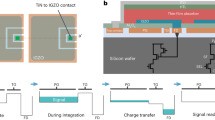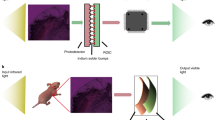Abstract
Organic semiconductor technology paves the way to low cost lightweight, flexible, printable electronics circuits and sensors. A novel lateral multilayer organic semiconductor photosensor is fabricated using small molecule organic semiconductor. A specialized interface layer is introduced between the metal electrodes and the organic semiconductor layer. The interface layer material is a large band gap and low electronic conductivity material. The use of interface layer limits the charge injection from the electrodes to the organic semiconductor and overall improves the photosensor dark current performance with an additional advantage to apply high voltage for improved collection. This design has low dark current with high photo-to-dark current ratio and can be set to high bias mode of operation.
Lateral interdigitated photodetector, with bottom contact Metal Semiconductor Metal (MSM) is fabricated consisting of interface layer and organic semiconductor bilayer. Small molecule organic semiconductor 3,4,9,10 perylenetetracarboxylic bisbenzimidazole (PTCBI) and Copper-Phthalocyanine (CuPc) are used as the active bilayer, where as polyamide forms the interface layer. Current through the sensor is measured in both dark and in light (wavelength 400nm). The dark current density in a 1mm2 photosensor area with 5µm lateral electrode spacing at 10V/µm measured equal to 10−5mA/cm2 and a photocurrent density of 10−3 mA/cm2 under 0.3mW/cm2 incident optical power. The photo to dark current ratio is measured to be equal to ~103.
This photosensor has an application in large area imaging for example portable lightweight detectors. Other applications of this sensor include indirect medial imaging and as a biosensor in UV Spectroscopy study of bacteria cultures.
Similar content being viewed by others
References
S. R. Forrest, “The path to ubiquitous and low-cost organic electronic appliances on plastic,” Nature, vol. 428, no. 6986, pp. 911–918, 2004.
K.-J. Baeg, M. Binda, D. Natali, M. Caironi, and Y.-Y. Noh, “Organic Light Detectors: Photodiodes and Phototransistors,” Adv. Mater., vol. 25, no. 31, pp. 4267–4295, Mar. 2013.
K. Wang, F. Chen, G. Belev, S. Kasap, and K. S. Karim, “Lateral metal-semiconductor-metal photodetectors based on amorphous selenium,” Appl. Phys. Lett., vol. 95, no. 1, pp. 013505–013505–3, 2009.
T. P. Osedach, S. M. Geyer, J. C. Ho, A. C. Arango, M. G. Bawendi, and V. Bulovic, “Lateral heterojunction photodetector consisting of molecular organic and colloidal quantum dot thin films,” Appl. Phys. Lett., vol. 94, no. 4, p. 043307, 2009.
J. C. Ho, A. Arango, and V. Bulovic, “Lateral organic bilayer heterojunction photoconductors,” Appl. Phys. Lett., vol. 93, no. 6, p. 063305, 2008.
U. Shafique and K. S. Karim, “Lateral organic photodetectors for imaging applications,” in Lateral organic photodetectors for imaging applications, Lake Buena Vista, FL, 2011, vol. 7961, pp. 796103–796103–6.
U. Shafique, C. Santato, K. S. Karim, “Lateral Organic Semiconductor Photodetector I: Use of an Insulating Layer for Low Dark Current ” IEEE Transaction on Electron Devices (Accepted), May 2014.
Acknowledgments
Financial support from the Natural Sciences and Engineering Council of Canada (NSERC) and the Ontario Research Fund (ORF) is acknowledged. The samples were fabricated and tested at the G2N Lab at the University of Waterloo.
Author information
Authors and Affiliations
Corresponding author
Rights and permissions
About this article
Cite this article
Shafique, U., Karim, K.S. UV Organic Semiconductor Photoconductor with Low Dark Current at High Electric Field. MRS Online Proceedings Library 1698, 53–58 (2014). https://doi.org/10.1557/opl.2014.881
Published:
Issue Date:
DOI: https://doi.org/10.1557/opl.2014.881




